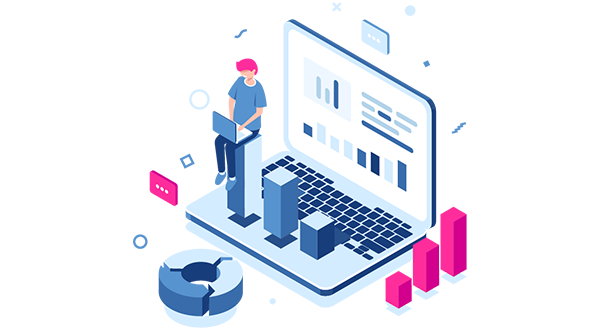

5 Ways Data Analytics Can Jump-Start Your Business

Did you know your business’s most important competitive asset lies in an invaluable treasure that may well be lying dormant, under-utilized-possibly even overlooked?
Commercial and consumer data; the crucial tidbits of information about anything from customer behavior and markets, metrics on internal activities like processing and shipping times, associated bottlenecks, downtimes and more are increasingly becoming the lifeblood of business. Without access to all your data, and the capacity to capture today’s dramatic upsurge in data from the internet, connected devices, video and emerging technologies, your business is flying blind.
Data Analytics Lets You Tap This Key Resource
Data analytics offers a scientific approach for businesses to quickly track organizational processes, analyze market trends, and strategically position their products and services to appeal to customers and prospects.
The capacity to immediately access all your business data has become so crucial that a 2021 Statista survey projects the data analytics market will reach $274.3 billion by 2022. This seismic shift in spending underlines business’s increasing reliance on hard data as the key factor driving planning and decision-making.
Moreover, the worldwide pandemic has forced businesses to the realization that their ability to react moment-to-moment to events is now a key determining factor in whether they can survive. So what are the top five most compelling reasons to leverage your data?
1. Gain Crucial Understanding of Consumer Behavior
A 2017 survey by McKinsey reveals that enterprises that leverage consumer behavior insights can outdo their competitors by 85% in sales growth and 25% in gross margin. It’s clear that gaining the deepest possible visibility into customer’s interactions via reliable data can give businesses a key advantage, letting them strategically align their products and services to changing buying patterns.
But to get the pulse of buyers you need to integrate data analytics tools at multiple points of contact along your marketing and sales processes. State of the art data analytics tools help you segment your audience in terms of demographics and buying priorities, letting you determine optimum price points, evaluate customer satisfaction, and analyze consumer behavior and interactions with your products and services.
Ultimately, this can help you enhance your product development process, optimize marketing and sales activities, and reallocate budgets to improve customer experience and get the most out of your marketing and branding efforts.
2. Good Data Lets You Hone Internal Business Processes
High quality business insights are crucial for leaders to gain a comprehensive view of the changing realities around their business. It sounds simple, but frequently the bulk of business data gets lost or distorted in cross-channel interactions, forcing leadership into time-intensive efforts to excavate meaningful information from management, which can lead to detrimental delays and unreliable insights.
But with reliable, high-capacity data analytics tools, executives can have all their business data at their fingertips, empowering them to make better-informed, more timely decisions. Clean, current data not only helps you predict future market trends; it also helps you streamline internal processes and ongoing business operations.
For example, a chief information officer can leverage quality data to know which supplies and personnel are required to meet current operational demands, to strategically reallocate budget and reconfigure logistics to ensure the smooth flow of resources and information throughout the organization.
Similarly, marketing teams and managers can use solid data as a reliable guide to upcoming market trends, letting them create campaigns that engage consumers and generate buzz for their products and services.
3. Better Utilization of Human Capital
Data analytics also plays a key role in recruiting, providing granular insights into the professional background of a wide pool of candidates, from work histories to professional achievements, education and even career goals. This information is crucial to generate a profile of both ideal and actual candidates and helps an organization choose the candidate most likely to fit both professionally and culturally into their business.
Interestingly, Gartner reports that only 21% of HR professionals believe their organizations are effectively utilizing data to support decision-making for talent acquisition. According to Gartner:
- 58% of recruiters find it difficult to acquire talent that aligns with their current business needs
- 64% of recruiters find it difficult to acquire talent to support a change in strategy
- 71% of recruiting organizations hire for more specialized roles compared to what they hired five years ago
- 20% of recruiters said a fifth of their current requisitions are for unfamiliar roles and it takes 38% more time to fill those roles
It’s clear businesses need to prioritize raising the analytics expertise of their HR workforce and empower them with the labor market analytics tools that give them access to timely labor market statistics, including data on:
- Talent and human resources Insights into top roles, hot skills, and top markets for specific skillsets
- Wages Information on current and future costs of hires based on the role and location
- Competitive landscape Insights into the hiring approaches of competitors, and which roles and skillsets they’re seeking
- Geography To allow financially viable hiring decisions that take into consideration the geography of a hire
- Candidates Info on the incentives that can attract potential talent including factors like compensation and benefits, work-life balance, advancement opportunities, seniority level and more
If you find you’re not attracting the right prospects for key roles, analytics can guide you to the solution.
4. Making Future-Oriented Financial Moves
Finances are literally the bottom line in running any organization, from operating costs to profit and loss, investment status, returns on those investments-and even fraud detection.
Yet a static balance sheet or general ledger can’t provide a true picture of the dynamic financial factors that impact your business, nor deliver micro-level data such as investment scope, costs, risks, and short- and long-term financial opportunities. But expert analytics provide businesses with the holistic view of earnings, profits and losses that’s essential to monitor progress, discover opportunities and preempt risk.
Financial analytics tools, integrated company-wide, can provide a clear, centralized view of all fiscal activities, as well as the evolving ecosystem surrounding the business, which can help leadership identify both emerging opportunities and hazards.
5. Using KPIs to Drive Business Performance
Data analytics is also critical to providing a comprehensive view of all aspects of business performance. By compiling data across all operational areas you can get the full picture, not only of the current and long-term health of your organization, but of the entire competitive landscape.
The competitive environment: A state of the art data platform not only provides internal insights, but can deliver key information on competitors as well as marketplace pressures and opportunities-information that, leveraged rapidly, lets you adapt to anticipate market trends and scoop the competition.
Vital supply chain dynamics: It’s never been more clear that the uninterrupted functioning of your supply chain is critical to the health of your business. Optimized data analytics can give you visibility into issues, actual and potential bottlenecks, as well as opportunities, letting you reduce inefficiencies and streamline overall supply chain management.
By getting ahead of these and all your other KPIs, you can optimize efficiencies and opportunities, foresee pitfalls and chart a clear path for growth.
You can’t see forward by only looking back
Old-school business intelligence simply extrapolates from historical information, using what’s past to forecast future business possibilities. But leading-edge data analytics platforms, with their capacity to take in ever-increasing terabytes of data from the internet, connected devices, media and more, offer you a true 360-degree view of your business, helping you move from descriptive data (what happened) to predictive modeling (what’s going to happen), to prescriptive analytics, i.e. how to prevent undesirable outcomes and ensure desirable ones.
It may be the one smartest investment a leader can make, since relying only on precedents in unprecedented times could lead to disaster.
mLogica can help
mLogica’s best-in-class CAP*M hyperscale big data platform can intake petabytes of structured, unstructured and semi-structured business data, integrating disparate data repositories for comprehensive, one-stop organizational reporting and analysis. Read more
For more information on how you can modernize your distributed and mainframe workloads to the cloud in one-third the time and at half the cost of traditional migrations, contact us at Modernize-Now@mLogica.com.








































